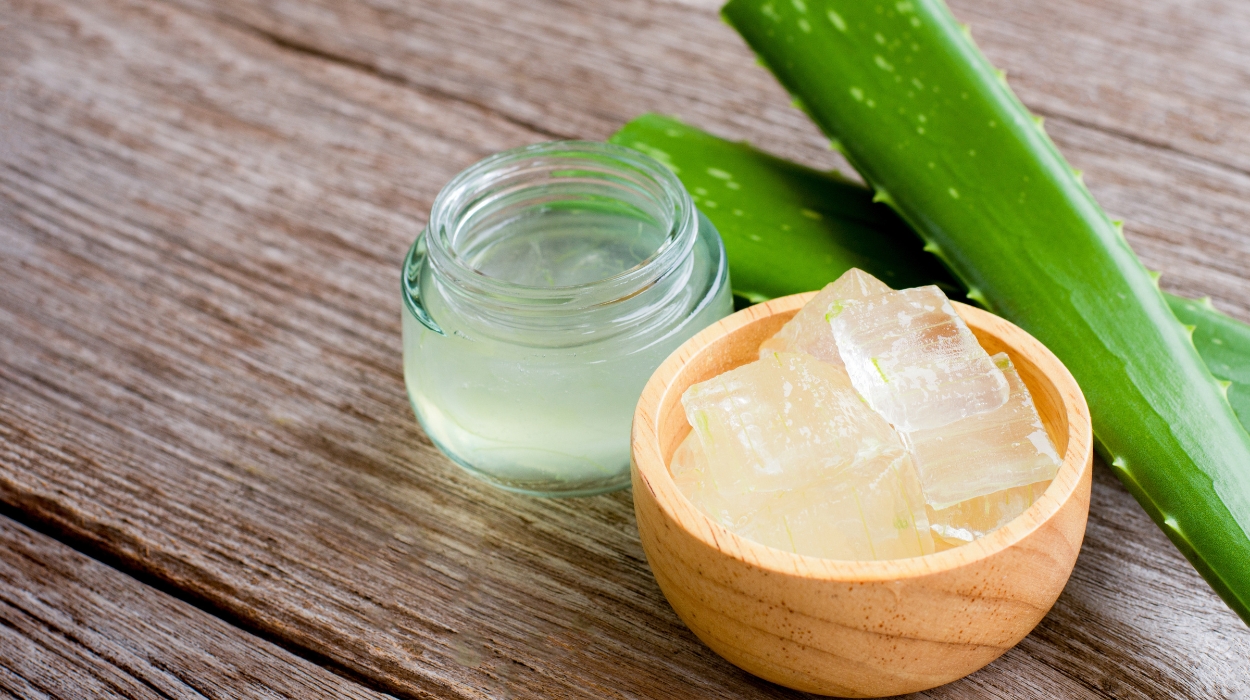 Expert's opinion
Expert's opinion
Expert's opinion
The article is a subjective view on this topic written by writers specializing in medical writing.
It may reflect on a personal journey surrounding struggles with an illness or medical condition, involve product comparisons, diet considerations, or other health-related opinions.
Although the view is entirely that of the writer, it is based on academic experiences and scientific research they have conducted; it is fact-checked by a team of degreed medical experts, and validated by sources attached to the article.
The numbers in parenthesis (1,2,3) will take you to clickable links to related scientific papers.
Humectants For Low Porosity Hair: Benefits In 2024

If you dive deeply into hair care, you’ll find numerous hair treatment remedies for hair growth and healing. You’ll come across hair masks, hot oil treatments, and even herbal remedies, among many others. But how many of these can you use on low-porosity hair? And what exactly are humectants for low-porosity hair?
Low-porosity hair refers to hair with tightly sealed cuticles, making it difficult for moisture to penetrate. Luckily, there are specific low-porosity hair products and remedies to help you with that.
If you’re struggling with hair that seems resistant to moisture and hydration, you’re not alone. This article will highlight the fascinating world of humectants and their role in caring for low-porosity hair.
We’ll define what they are and give you a list of the best to use. Let’s get started.
List Of Humectants For Low Porosity Hair
Here are some humectants that can help low-porosity hair health:
- Aloe vera gel.
- Natural oils.
- Hyaluronic acid.
- Glycerin.
- Honey.
- Panthenol, i.e., Provitamin B5.
- Sorbitol.
These humectants attract and retain moisture, helping hydrate and nourish low-porosity hair strands.
Incorporating products containing these humectants into your hair care routine can significantly improve moisture retention and promote healthier, more manageable hair.
Best Humectants For Low-Porosity Hair
There are several key ingredients to look for when researching the best humectants for low-porosity hair. Here are some of the top humectants to consider:
Aloe Vera Gel

Aloe vera[1] is a natural humectant that may deeply hydrate low-porosity hair while soothing the scalp. It penetrates the hair shaft, delivering hydration and promoting a healthy environment for hair growth.
Natural Oils
Natural oils[2] include olive oil, coconut oil,[3] sweet almond oil, and argan oil. These nourishing oils, rich in fatty acids, act as humectants for low-porosity hair. Hair hydrated with these oils can become deeply moisturized. For example, coconut oil helps reduce protein loss,[4] and sweet almond oil seals in moisture, leaving the hair soft and manageable.
Argan oil is antioxidant and essential fatty acid-rich. It may provide deep healing from oxidative stress[5] on low-porosity hair, improving elasticity and adding shine.
Please note that not all natural hair oils are humectants.
Hyaluronic Acid
Hyaluronic acid[6] is a potent natural substance known for its exceptional ability to attract and retain moisture. It can hold more water over its weight, making it highly effective at hydrating low-porosity hair.[7]
Glycerin
Glycerin[8] is a versatile humectant that draws moisture from the air and locks all the moisture into the hair strands. It can take in its own weight in three days.[9] So in that duration, it may improve hair hydration preventing water loss from the hair.
Honey
Honey[10] gives your hair much-needed moisture, leaving it soft, smooth, and shiny.
It also has antimicrobial and antioxidant properties,[11] which can contribute to a healthier scalp and hair.
Panthenol
Panthenol attracts and retains moisture from the environment and penetrates the hair shaft. It’s excellent for your scalp skin’s deep hydration.[12] It may improve the low-porosity hair’s elasticity and flexibility. Panthenol also helps to smooth the hair cuticles, reducing frizz[13] and enhancing shine.
Sorbitol
Studies support that a sugar alcohol called sorbitol boosts the hair’s water content.[14] Sorbitol forms a protective barrier that helps to prevent moisture loss. This barrier results in improved hydration and softness of the hair.
What Are Humectants In Haircare?
Humectants[15] for hair care are moisture-attracting ingredients crucial in hydrating and nourishing hair. Humectants first draw moisture from the environment. They also draw moisture from the inner layer of the skin and bind it to the hair fiber.
If you have low-porosity hair, humectants can help overcome your hair’s resistance to moisture absorption. Incorporating humectant hair products like leave-in or deep conditioners allows your hair cuticles to retain essential moisture. It also enhances hair health and promotes hydrated, lustrous locks.
How Do Humectants Work For Low Porosity Hair?
Low-porosity hair repels water, but a humectant can help hair absorb moisture instead. Here’s how:
Humectants can penetrate the tightly sealed cuticles of low-porosity hair, attracting moisture from the surrounding environment.
They also pull moisture from the air and bind it to the hair strands. They might form a protective layer on the hair surface, preventing moisture loss.
Benefits Of Humectants For Low-Porosity Hair

Now that you understand how they work, here are the benefits you get from using humectants:
Improved Moisture Retention
Humectants help low-porosity dull hair retain much-needed moisture, addressing issues of dryness and brittleness. Film-forming[16] conditioning humectants may promote less hair friction and, thus less frizz.
Increased Absorption Of Hair Products
Product build-up is common when you use hair products, and dry hair doesn’t take it all in.
Thankfully, humectants let your strands take in conditioners, oils, and styling products more effectively.
This enhances the overall effectiveness of your hair care routine, maximizing the benefits of other nourishing ingredients.
Weightless Hydration
Unlike heavy oils or hair butter, humectants provide hydration without weighing down low-porosity hair. They have a lightweight texture, allowing your hair to maintain its natural volume and bounce.
Ways To Incorporate Humectants In Your Hair Routine
Now that you know what to have in your low-porosity hair care routine, here’s how to moisturize low-porosity hair:
- Deep condition your hair with products enriched with humectants like aloe vera gel, glycerin, or hyaluronic acid.
- Apply natural oils such as coconut, olive, or sweet almond oil to seal in moisture.
- Opt for hair products specifically formulated for low-porosity hair that contain humectants.
- Create a DIY hair mask using humectant-rich ingredients such as aloe vera gel, honey, or glycerin.
- Consider deep conditioning with added humectants to provide intense hydration and nourishment.
- Avoid excessive heat styling or overuse of clarifying shampoos. These can strip away moisture and hinder the effectiveness of humectants.
- Opt for natural humectants and use hair-moisturizing supplements like collagen or biotin supplements.
Ingredients To Avoid For Low-Porosity Hair
When maintaining low-porosity healthy hair, it’s essential to be mindful of certain harmful ingredients. Here are some elements to avoid:
- Heavy Oils: Avoid heavy oils like avocado oil, jojoba oil, or castor oil, as they can weigh down low-porosity hair and lead to product buildup.
- Silicone-Based Products: Silicone-based ingredients like dimethicone[17] can create a barrier on the hair shaft, preventing moisture from penetrating and potentially causing buildup.
- Sulfates: Sulfates, such as sodium laureth or lauryl sulfate,[18] or ammonium lauryl sulfate,[19] can be harsh and strip the hair of its natural oils. They leave hair dry and prone to damage.
- Alcohol-Based Products: Avoid products drying alcohols like ethanol or isopropyl alcohol, which can induce free radical damage[20] to the hair. This further dehydrates the hair and leads to increased dryness.
- Wax-Based Products: Wax-based ingredients like mineral oil or petrolatum may create a heavy, greasy buildup on low-porosity hair, inhibiting moisture absorption.
- High pH Products: Chemical treatments with a high pH level[21] can disrupt the hair’s natural pH balance. These may result in damaged hair.
By being mindful of these ingredients, you can ensure your low-porosity hair receives the care it needs without unnecessary buildup or damage.
Summary
Using humectants for your low-porosity strands can be highly beneficial to ensure your hair gets back to normal porosity. Humectants attract moisture, helping hydrate and moisturize the hair strands. By using them regularly, your hair shines, bounces, and is deeply hydrated for optimal growth.
Consider your hair’s porosity level and adjust usage based on climate for your natural journey. Skin and hair specialists like dermatologists can help you find the best according to your hair’s porosity level. Finally, for long-term results, you should pair humectants with sealants for optimal moisture retention.
Frequently Asked Questions
Humectants can be used on all hair types, but their effectiveness may vary. Adjust usage based on your hair’s specific needs.
Yes, humectants can benefit high-porosity hair by attracting moisture and helping to retain it, improving overall hydration.
Yes, humectants can still be effective in dry climates, but consider using them alongside sealants like oils or butter to prevent moisture loss.
It depends on your hair’s needs. Experiment and observe how your hair responds, but start with once or twice a week and adjust accordingly.
+ 21 sources
Health Canal avoids using tertiary references. We have strict sourcing guidelines and rely on peer-reviewed studies, academic researches from medical associations and institutions. To ensure the accuracy of articles in Health Canal, you can read more about the editorial process here
- Sampath, P., Bhowmik, D., Bhattacharjee, C. and Biswajit (2010). Aloe vera : A Potential Herb and its Medicinal Importance. [online] ResearchGate. Available at: https://www.researchgate.net/publication/328630465_Aloe_vera_A_Potential_Herb_and_its_Medicinal_Importance.
- Mysore, V. and Arpita Arghya (2022). Hair oils: Indigenous knowledge revisited. International Journal of Trichology, [online] 14(3), pp.84–84. doi:https://doi.org/10.4103/ijt.ijt_189_20.
- Saxena, R., Mittal, P., Clavaud, C., Dhakan, D.B., Roy, N., Breton, L., Misra, N. and Sharma, V.K. (2021). Longitudinal study of the scalp microbiome suggests coconut oil to enrich healthy scalp commensals. Scientific Reports, [online] 11(1). doi:https://doi.org/10.1038/s41598-021-86454-1.
- Wallace, T.C. (2018). Health Effects of Coconut Oil—A Narrative Review of Current Evidence. Journal of The American College of Nutrition, [online] 38(2), pp.97–107. doi:https://doi.org/10.1080/07315724.2018.1497562.
- Sharifi, N., Sanaz Hamedeyazdan, Javad Shokri and Farnaz Monajjemzadeh (2022). Argan oil as a pretreatment of human hair before exposure to oxidative damage: Attenuated total reflectance and protein loss studies. Journal of Cosmetic Dermatology, [online] 21(10), pp.5010–5017. doi:https://doi.org/10.1111/jocd.14885.
- Zerbinati, N., Sommatis, S., Maccario, C., Capillo, M.C., Serena Di Francesco, Rauso, R., Protasoni, M., Edoardo D’Este, Daniela Dalla Gasperina and Mocchi, R. (2021). In Vitro Hair Growth Promoting Effect of a Noncrosslinked Hyaluronic Acid in Human Dermal Papilla Cells. BioMed Research International, [online] 2021, pp.1–6. doi:https://doi.org/10.1155/2021/5598110.
- Papakonstantinou, E., Roth, M. and Karakiulakis, G. (2012). Hyaluronic acid: A key molecule in skin aging. Dermato-endocrinology, [online] 4(3), pp.253–258. doi:https://doi.org/10.4161/derm.21923.
- Harding (2014). A high glycerol-containing leave-on scalp care treatment to improve dandruff. Skinmed, [online] 12(3). Available at: https://pubmed.ncbi.nlm.nih.gov/25134312/
- Chen, H.J., Lee, P.Y., Chen, C.Y., Huang, S.L., Huang, B.W., Dai, F.J., Chau, C.F., Chen, C.S. and Lin, Y.S. (2022). Moisture retention of glycerin solutions with various concentrations: a comparative study. Scientific Reports, [online] 12(1). doi:https://doi.org/10.1038/s41598-022-13452-2.
- Hadi, H., Omar, S. and Ammar Awadh (2016). Honey, a Gift from Nature to Health and Beauty: A Review. [online] ResearchGate. Available at: https://www.researchgate.net/publication/310435905_Honey_a_Gift_from_Nature_to_Health_and_Beauty_A_Review.
- Christos Stefanis, Elisavet Stavropoulou, Giorgi, E., Chrysoula (Chrysa) Voidarou, Constantinidis, T.C., Vrioni, G. and Athanasios Tsakris (2023). Honey’s Antioxidant and Antimicrobial Properties: A Bibliometric Study. Antioxidants, [online] 12(2), pp.414–414. doi:https://doi.org/10.3390/antiox12020414.
- Yoon Sun Cho, Hye One Kim, Seung Man Woo and Dong Hun Lee (2022). Use of Dexpanthenol for Atopic Dermatitis—Benefits and Recommendations Based on Current Evidence. Journal of Clinical Medicine, [online] 11(14), pp.3943–3943. doi:https://doi.org/10.3390/jcm11143943.
- Fernández-Peña, L. and Guzmán, E. (2020). Physicochemical Aspects of the Performance of Hair-Conditioning Formulations. [online] ResearchGate. Available at: https://www.researchgate.net/publication/340535456_Physicochemical_Aspects_of_the_Performance_of_Hair-Conditioning_Formulations.
- Egawa, M., Hagihara, M. and Yanai, M. (2012). Near‐infrared imaging of water in human hair. Skin Research and Technology, [online] 19(1), pp.35–41. doi:https://doi.org/10.1111/j.1600-0846.2012.00651.x.
- Sethi, A., Kaur, T., Malhotra, S. and Gambhir, M. (2016). Moisturizers: The slippery road. Indian Journal of Dermatology, [online] 61(3), pp.279–279. doi:https://doi.org/10.4103/0019-5154.182427.
- Fernandes, C., Medronho, B., Alves, L. and Maria Graça Rasteiro (2023). On Hair Care Physicochemistry: From Structure and Degradation to Novel Biobased Conditioning Agents. Polymers, [online] 15(3), pp.608–608. doi:https://doi.org/10.3390/polym15030608.
- Fernanda, M. (2015). Hair cosmetics: An overview. International Journal of Trichology, [online] 7(1), pp.2–2. doi:https://doi.org/10.4103/0974-7753.153450.
- Assaf Monselise, Cohen, D.E., Wanser, R. and Shapiro, J. (2015). What ages hair? International Journal of Women’s Dermatology, [online] 1(4), pp.161–166. doi:https://doi.org/10.1016/j.ijwd.2015.07.004.
- Fernanda, M. (2018). Pro and Contra of Cleansing Conditioners. Skin appendage disorders, [online] 5(3), pp.131–134. doi:https://doi.org/10.1159/000493588.
- Eun Ju Ha, Yun, J.-H., Si, C., Young Soo Bae, Jeong, Y.-H., Park, K.-H. and Choi, S.-E. (2021). Application of Ethanol Extracts From Alnus sibirica Fisch. ex Turcz in Hair Growth Promotion. Frontiers in Bioengineering and Biotechnology, [online] 9. doi:https://doi.org/10.3389/fbioe.2021.673314.
- Fernanda, M., Munck, A., Makino, P., Andre Ricardo Adriano and Pichler, J. (2014). The shampoo pH can affect the hair: Myth or Reality? International Journal of Trichology, [online] 6(3), pp.95–95. doi:https://doi.org/10.4103/0974-7753.139078.



